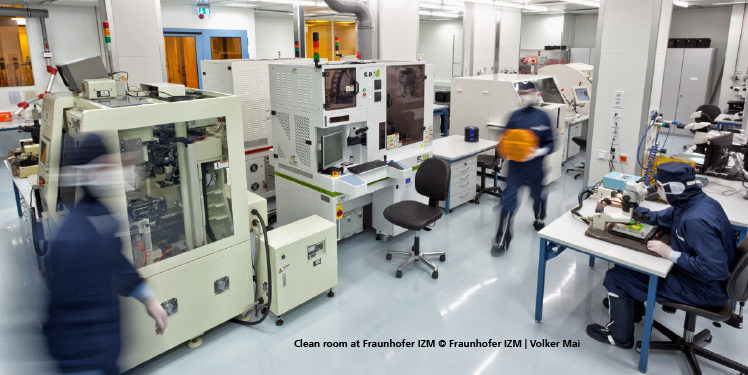Welcome to our list of three disruptive technologies in microelectronics. This post will let you discover the trends that will significantly change the global technological development.
Chips Embedded in Substrate
It is hard to miss the unbroken trend towards ever-smaller devices packing ever more features. Researchers are working hard to deliver the technologies that satisfy the needs of the market. One such technology is the embedding of semiconductor chips and other passive components into the build-up layers of substrates. It is technologies like these that make modern System-in-Package (SIP) or other complex systems possible in the first place.
On the one hand, embedding chips right in the substrate promises a lot of benefits. First, it allows the sequential stacking of multiple layers containing embedded components, which makes a very high degree of miniaturization possible. Second, electrical performance can be optimized. Third, the technology improves the reliability of packaging by placing chips in a homogeneous physical environment. Finally, the technology makes it possible to manufacture thin planar packages and stacked SiPs.
On the other hand, there are still several technological challenges that need to be overcome, such as the integration of optics in substrates, the continued increasing of circuit density, the use of chip embedding for high frequency applications, and the embedded components’ shape-conforming to any surface and many more.
In their continued work on novel embedding technologies and industrial applications, many research institutes and universities have committed to several projects. Fraunhofer IZM and TU Berlin worked together to develop the so-called Chip-in-Polymer technology, which allows the realization of SIPs as well as boards with integrated components. The EU-funded project “HIDING DIES” has led to a stable technology platform for unparalleled integration, with the embedding technology successfully using the lamination of RCC and laser via interconnects to chip pads. The project also produced versatile solutions for 3D SiP modules. The project has shown the enormous potential of chip embedding for miniaturized electronic systems. The new “HERMES” project, also supported by EU funding, focuses more on the industrialization of embedding technology and aims to bring it into real-life PCB manufacturing. The embedding of chips in substrates has also been applied in the development of fully integrated power switches, power PCB, and medical modules. The achievements of past and current projects like these show the immense potential of chip embedding technology for industrial applications.
RF Packaging for 5G
The 5th generation mobile network (5G) is a set of emerging mobile technologies that bring new frequencies and a larger bandwidth than the established 3/4G systems. 5G is expected to achieve a 1000-fold increase in wireless capacity and create reliable internet access with latencies of less than 10ms.
2019 marks a milestone for this technology, with numerous frequencies auctioned off by the German government. 5G systems rely on frequency bands reaching 26, 38/39GHz, which imposes new requirements on their technical design. Two critical enabling technologies can be identified for the physical layer of 5G technologies: beamforming, massive mimo and millimeter-wave frequencies.
The new generation of mobile networks will rely heavily on phased arrays. Phased shifters are added to subarray element in the array, which enable the antenna beam to be steered. Rather than understanding antennas as separate components that are separately packaged, 5G packaging involves smart and highly integrated solutions. Another major change for the physical layer can be identified in the shift to millimeter-wave frequencies in future mobile networks. MM-wave frequency bands offer enormous bandwidth, making it possible to overcome the limitations of familiar 4G systems.
However, having components and interconnects with a physical size comparable to a wavelength makes packaging for 5G systems more challenging than ever. Additional design issues for RF packaging include material selection, coupling between traces, design of the metal patterns, and dissipated power density.
5G is suited for all human (HCC) and machine (MTC) interactions. These include applications for smart infrastructure as well as intelligent solutions for healthcare, energy, logistics, industrial production (Industry 4.0), and urban planning. It enables operators to control machinery, grids, or factories from afar and provides mobile broadband access even in crowded places.
Since 2018, Fraunhofer IZM has been working within the EU project SERENA on innovative and cost-efficient 5G systems and researching RF packaging technologies with cost-efficient gallium nitride on silicon (GaN-on-Si) and silicon germanium (SiGe) components and heterogeneous casing designs.
Silicon Carbide and Gallium Nitride – New Semiconductor Solutions
As technology advances, new fields of application continue to emerge. In turn, this creates newer and more complex technical requirements that standard components need to fulfil. Surfing, rather than trying to stem that tide, microelectronics researchers are working on developing new wide-bandgap semiconductor technologies, such as silicon carbide (SiC) and gallium nitride (GaN) solutions.
SiC and GaN semiconductors use a promising combination of chemical and physical properties, potentially paving the way for new achievements in terms of improving reliability, reducing losses, and operating at higher voltages, frequencies, and temperatures. As a result, devices may be miniaturized even more, charge much fast, use less power, and achieve much higher energy conversion rates.
However, the move towards SiC and GaN semiconductors is hampered by a number of disadvantages: The development tools must support the new materials’ properties, and new packaging technologies are needed to withstand higher operating temperatures. Moreover, compared to silicon technology, wide bandgap semiconductors usually need to be applied to substrates made from other (easier to produce) materials.
While silicon is expected to remain the mainstream power semiconductor material, SiC and GaN seem particularly suitable for the power semiconductor devices needed by electric cars and mobile devices. GaN components are increasingly being used in high-frequency power amplifiers for the mobile network infrastructure, while SiC power semiconductors promise new advances in automotive and photovoltaic power electronics.
It is estimated that the price of SiC and GaN solutions will decline gradually in 2020, making the technology much more likely to capture a greater share of the market.
These new types of semiconductors are already being actively applied in R&D work. For instance, Fraunhofer IZM teamed up with its project partner, the Rogers Corporation, to produce a low-intendance power module using silicon carbide and gallium nitride semiconductors, which has the same module size as conventional modules, while generate up to 30% more power.
This article was edited by Yulia Fedorovich from Fraunhofer IZM Marketing & Business Development department.
IT CAN BE ALSO INTERESTING FOR YOU:
- How Design Superpowers Will Save Our Planet
- Indoor Positioning Systems, or: How not to Get Lost in an Airport
- How Waterproof Flexible LED Systems Became a Reality



Anonymous says:
Like!! Thank you for publishing this awesome article.